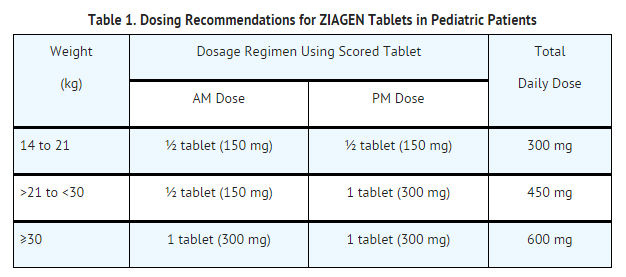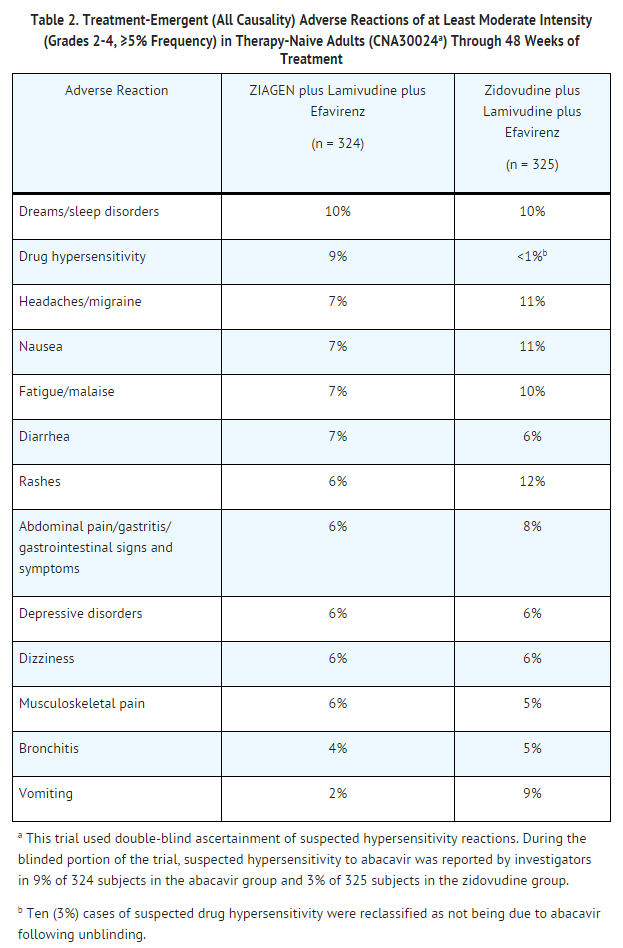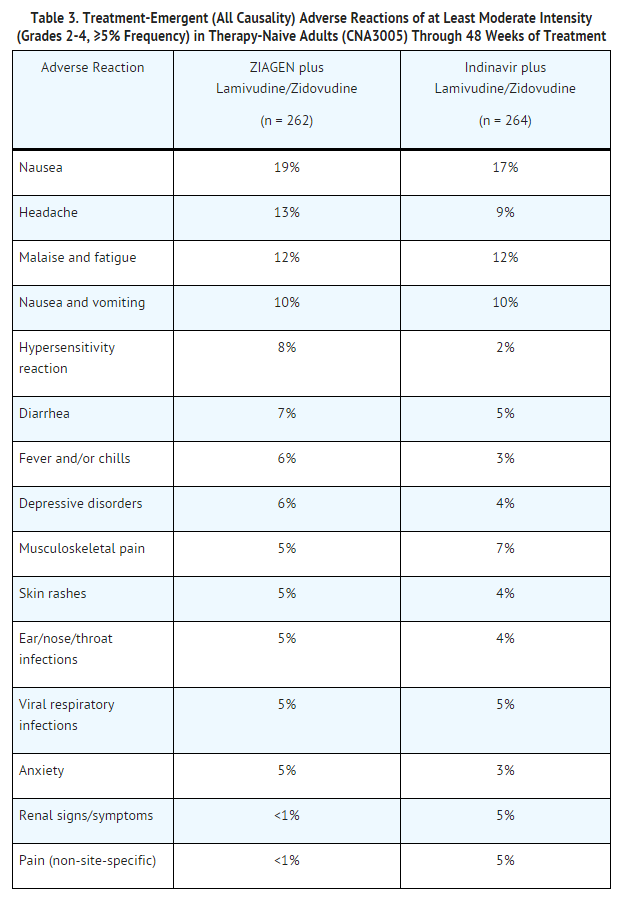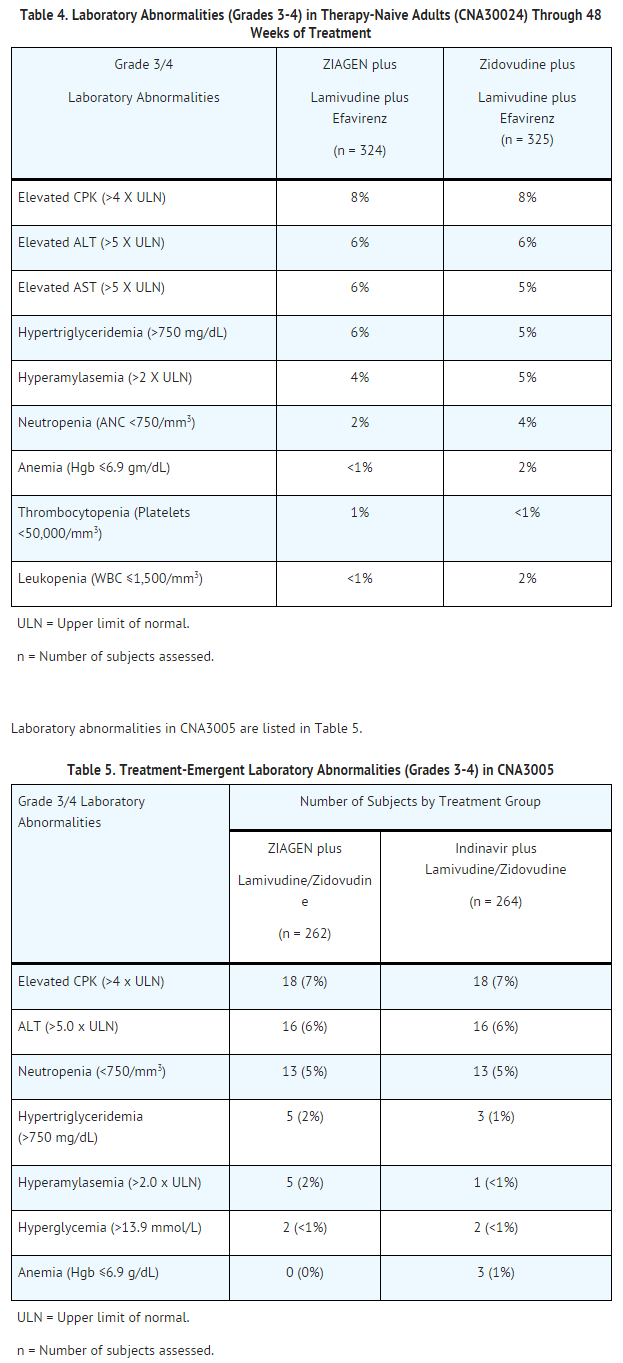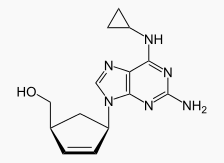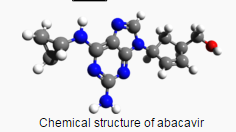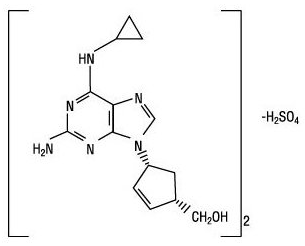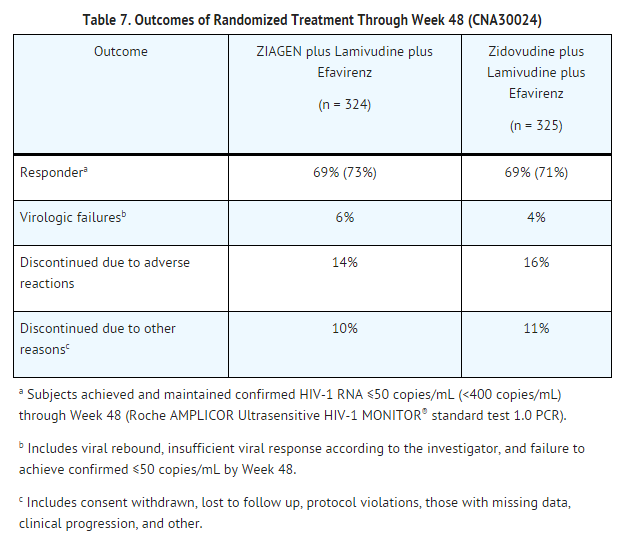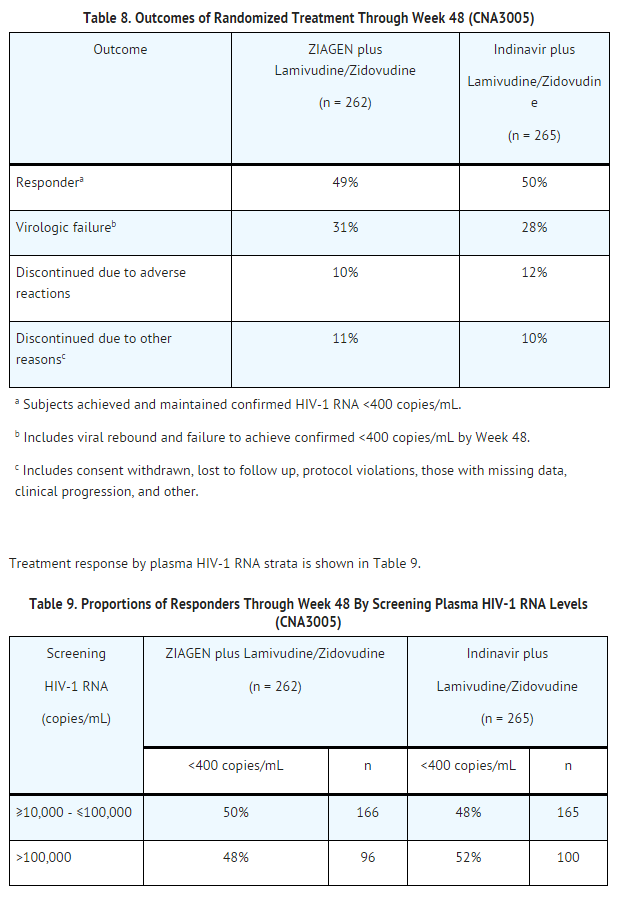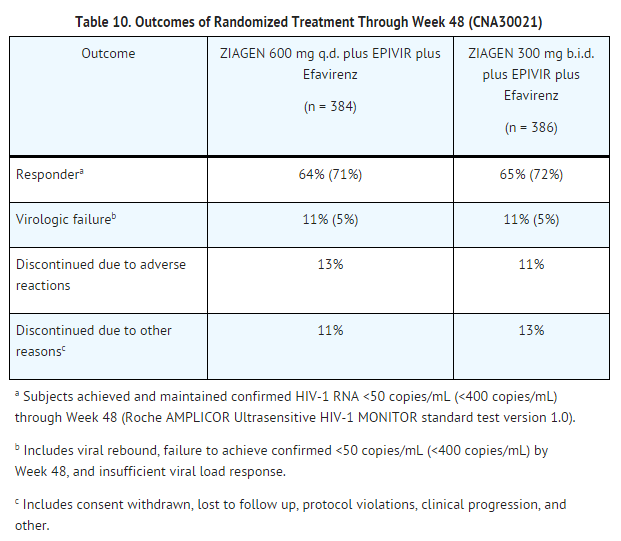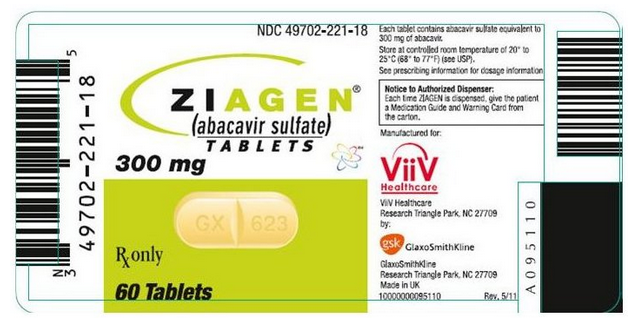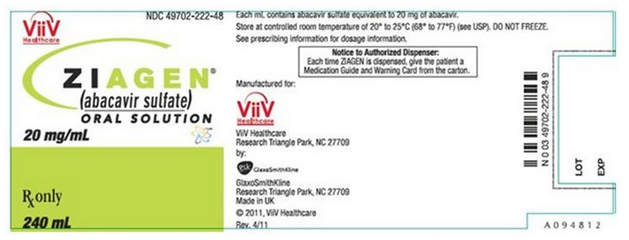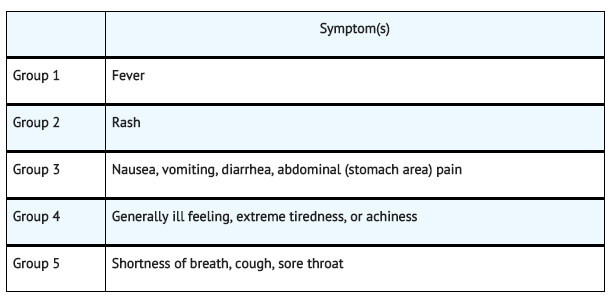Abacavir
Editor-In-Chief: C. Michael Gibson, M.S., M.D. [1]; Associate Editor(s)-in-Chief: Rabin Bista, M.B.B.S. [2]
Disclaimer
WikiDoc MAKES NO GUARANTEE OF VALIDITY. WikiDoc is not a professional health care provider, nor is it a suitable replacement for a licensed healthcare provider. WikiDoc is intended to be an educational tool, not a tool for any form of healthcare delivery. The educational content on WikiDoc drug pages is based upon the FDA package insert, National Library of Medicine content and practice guidelines / consensus statements. WikiDoc does not promote the administration of any medication or device that is not consistent with its labeling. Please read our full disclaimer here.
Black Box Warning
|
WARNING: RISK OF HYPERSENSITIVITY REACTIONS, LACTIC ACIDOSIS, AND SEVERE HEPATOMEGALY
See full prescribing information for complete Boxed Warning.
* Hypersensitivity Reactions: Serious and sometimes fatal hypersensitivity reactions have been associated with ZIAGEN® (abacavir sulfate).
|
Overview
Abacavir is a nucleoside analogue that is FDA approved for the treatment of HIV-1 infection. There is a Black Box Warning for this drug as shown here. Common adverse reactions include nausea, headache, malaise and fatigue, nausea and vomiting, and dreams/sleep disorders..
Adult Indications and Dosage
FDA-Labeled Indications and Dosage (Adult)
Indications
- ZIAGEN Tablets and Oral Solution, in combination with other antiretroviral agents, are indicated for the treatment of human immunodeficiency virus (HIV-1) infection.
- Additional important information on the use of ZIAGEN for treatment of HIV-1 infection:
- ZIAGEN is one of multiple products containing abacavir. Before starting ZIAGEN, review medical history for prior exposure to any abacavir-containing product in order to avoid reintroduction in a patient with a history of hypersensitivity to abacavir
Dosage
- A Medication Guide and Warning Card that provide information about recognition of hypersensitivity reactions should be dispensed with each new prescription and refill.
- ZIAGEN may be taken with or without food.
Adult Patients
- The recommended oral dose of ZIAGEN for adults is 600 mg daily, administered as either 300 mg twice daily or 600 mg once daily, in combination with other antiretroviral agents.
Patients With Hepatic Impairment
- The recommended dose of ZIAGEN in patients with mild hepatic impairment (Child-Pugh score 5 to 6) is 200 mg twice daily. To enable dose reduction, ZIAGEN Oral Solution (10 mL twice daily) should be used for the treatment of these patients. The safety, efficacy, and pharmacokinetic properties of abacavir have not been established in patients with moderate to severe hepatic impairment; therefore, ZIAGEN is contraindicated in these patients.
DOSAGE FORMS AND STRENGTHS
- ZIAGEN Tablets contain 300 mg of abacavir as abacavir sulfate. The tablets are yellow, biconvex, scored, capsule-shaped, film-coated, and imprinted with “GX 623” on both sides.
- ZIAGEN Oral Solution contains 20 mg/mL of abacavir as abacavir sulfate. The solution is a clear to opalescent, yellowish, strawberry-banana-flavored liquid.
Off-Label Use and Dosage (Adult)
Guideline-Supported Use
There is limited information regarding Off-Label Guideline-Supported Use of Abacavir in adult patients.
Non–Guideline-Supported Use
There is limited information regarding Off-Label Non–Guideline-Supported Use of Abacavir in adult patients.
Pediatric Indications and Dosage
FDA-Labeled Indications and Dosage (Pediatric)
Dosage
Pediatric Patients
- The recommended oral dose of ZIAGEN Oral Solution in HIV-1-infected pediatric patients aged 3 months and older is 8 mg/kg twice daily (up to a maximum of 300 mg twice daily) in combination with other antiretroviral agents.
- ZIAGEN is also available as a scored tablet for HIV-1-infected pediatric patients weighing greater than or equal to 14 kg for whom a solid dosage form is appropriate. Before prescribing ZIAGEN Tablets, children should be assessed for the ability to swallow tablets. If a child is unable to reliably swallow ZIAGEN Tablets, the oral solution formulation should be prescribed. The recommended oral dosage of ZIAGEN Tablets for HIV-1-infected pediatric patients is presented in Table 1.
Off-Label Use and Dosage (Pediatric)
Guideline-Supported Use
There is limited information regarding Off-Label Guideline-Supported Use of Abacavir in pediatric patients.
Non–Guideline-Supported Use
There is limited information regarding Off-Label Non–Guideline-Supported Use of Abacavir in pediatric patients.
Contraindications
- ZIAGEN is contraindicated in patients with:
- previously demonstrated hypersensitivity to abacavir or any other component of the products. NEVER restart ZIAGEN or any other abacavir-containing product following a hypersensitivity reaction to abacavir, regardless of HLA-B*5701 status.
- moderate or severe hepatic impairment
Warnings
|
WARNING: RISK OF HYPERSENSITIVITY REACTIONS, LACTIC ACIDOSIS, AND SEVERE HEPATOMEGALY
See full prescribing information for complete Boxed Warning.
* Hypersensitivity Reactions: Serious and sometimes fatal hypersensitivity reactions have been associated with ZIAGEN® (abacavir sulfate).
|
Hypersensitivity Reaction
- Serious and sometimes fatal hypersensitivity reactions have been associated with ZIAGEN and other abacavir-containing products. Patients who carry the HLA-B*5701 allele are at high risk for experiencing a hypersensitivity reaction to abacavir. Prior to initiating therapy with abacavir, screening for the HLA-B*5701 allele is recommended; this approach has been found to decrease the risk of a hypersensitivity reaction. Screening is also recommended prior to reinitiation of abacavir in patients of unknown HLA-B*5701 status who have previously tolerated abacavir. For HLA-B*5701-positive patients, treatment with an abacavir-containing regimen is not recommended and should be considered only with close medical supervision and under exceptional circumstances when the potential benefit outweighs the risk.
- HLA-B*5701-negative patients may develop a hypersensitivity reaction to abacavir; however, this occurs significantly less frequently than in HLA-B*5701-positive patients.
- Regardless of HLA-B*5701 status, permanently discontinue ZIAGEN if hypersensitivity cannot be ruled out, even when other diagnoses are possible.
- Important information on signs and symptoms of hypersensitivity, as well as clinical management, is presented below. Signs and Symptoms of
- Hypersensitivity: Hypersensitivity to abacavir is a multi-organ clinical syndrome usually characterized by a sign or symptom in 2 or more of the following groups.
- Group 1: Fever
- Group 2: Rash
- Group 3: Gastrointestinal (including nausea, vomiting, diarrhea, or abdominal pain)
- Group 4: Constitutional (including generalized malaise, fatigue, or achiness)
- Group 5: Respiratory (including dyspnea, cough, or pharyngitis).
- Hypersensitivity to abacavir following the presentation of a single sign or symptom has been reported infrequently.
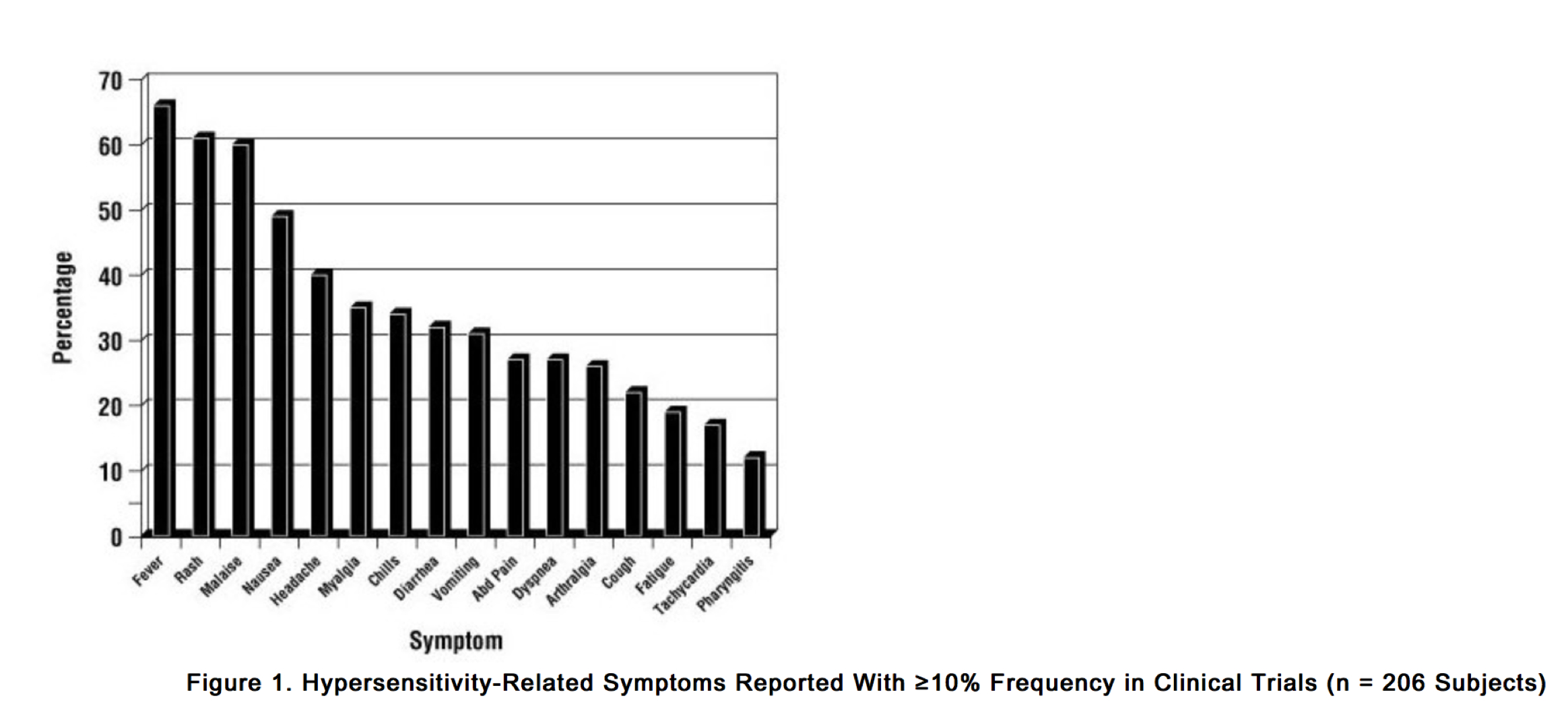
- Hypersensitivity to abacavir was reported in approximately 8% of 2,670 subjects (n = 206) in 9 clinical trials (range: 2% to 9%) with enrollment from November 1999 to February 2002. Data on time to onset and symptoms of suspected hypersensitivity were collected on a detailed data collection module. The frequencies of symptoms are shown in Figure 1. Symptoms usually appeared within the first 6 weeks of treatment with abacavir, although the reaction may occur at any time during therapy. Median time to onset was 9 days; 89% appeared within the first 6 weeks; 95% of subjects reported symptoms from 2 or more of the 5 groups listed above.
- Other less common signs and symptoms of hypersensitivity include lethargy, myolysis, edema, abnormal chest x-ray findings (predominantly infiltrates, which can be localized), and paresthesia. Anaphylaxis, liver failure, renal failure, hypotension, adult respiratory distress syndrome, respiratory failure, and death have occurred in association with hypersensitivity reactions. In one trial, 4 subjects (11%) receiving ZIAGEN 600 mg once daily experienced hypotension with a hypersensitivity reaction compared with 0 subjects receiving ZIAGEN 300 mg twice daily.
Physical findings associated with hypersensitivity to abacavir in some patients include lymphadenopathy, mucous membrane lesions (conjunctivitis and mouth ulcerations), and rash. The rash usually appears maculopapular or urticarial, but may be variable in appearance. There have been reports of erythema multiforme. Hypersensitivity reactions have occurred without rash.
- Laboratory abnormalities associated with hypersensitivity to abacavir in some patients include elevated liver function tests, elevated creatine phosphokinase, elevated creatinine, and lymphopenia.
- Clinical Management of Hypersensitivity: Discontinue ZIAGEN as soon as a hypersensitivity reaction is suspected. To minimize the risk of a life-threatening hypersensitivity reaction, permanently discontinue ZIAGEN if hypersensitivity cannot be ruled out, even when other diagnoses are possible (e.g., acute onset respiratory diseases such as pneumonia, bronchitis, pharyngitis, or influenza; gastroenteritis; or reactions to other medications).
- Following a hypersensitivity reaction to abacavir, NEVER restart ZIAGEN or any other abacavir-containing product because more severe symptoms can occur within hours and may include life-threatening hypotension and death.
- When therapy with ZIAGEN has been discontinued for reasons other than symptoms of a hypersensitivity reaction, and if reinitiation of ZIAGEN or any other abacavir-containing product is under consideration, carefully evaluate the reason for discontinuation of ZIAGEN to ensure that the patient did not have symptoms of a hypersensitivity reaction. If the patient is of unknown HLA-B*5701 status, screening for the allele is recommended prior to reinitiation of ZIAGEN.
- If hypersensitivity cannot be ruled out, DO NOT reintroduce ZIAGEN or any other abacavir-containing product. Even in the absence of the HLA-B*5701 allele, it is important to permanently discontinue abacavir and not rechallenge with abacavir if a hypersensitivity reaction cannot be ruled out on clinical grounds, due to the potential for a severe or even fatal reaction.
If symptoms consistent with hypersensitivity are not identified, reintroduction can be undertaken with continued monitoring for symptoms of a hypersensitivity reaction. Make patients aware that a hypersensitivity reaction can occur with reintroduction of ZIAGEN or any other abacavir-containing product and that reintroduction of ZIAGEN or any other abacavir-containing product needs to be undertaken only if medical care can be readily accessed by the patient or others.
- Risk Factor: HLA-B*5701 Allele: Trials have shown that carriage of the HLA-B*5701 allele is associated with a significantly increased risk of a hypersensitivity reaction to abacavir.
- CNA106030 (PREDICT-1), a randomized, double-blind trial, evaluated the clinical utility of prospective HLA-B*5701 screening on the incidence of abacavir hypersensitivity reaction in abacavir-naive HIV-1-infected adults (n = 1,650). In this trial, use of pre-therapy screening for the HLA-B*5701 allele and exclusion of subjects with this allele reduced the incidence of clinically suspected abacavir hypersensitivity reactions from 7.8% (66/847) to 3.4% (27/803). Based on this trial, it is estimated that 61% of patients with the HLA-B*5701 allele will develop a clinically suspected hypersensitivity reaction during the course of abacavir treatment compared with 4% of patients who do not have the HLA-B*5701 allele.
Screening for carriage of the HLA -B*5701 allele is recommended prior to initiating treatment with abacavir. Screening is also recommended prior to reinitiation of abacavir in patients of unknown HLA-B*5701 status who have previously tolerated abacavir. For HLA-B*5701-positive patients, initiating or reinitiating treatment with an abacavir-containing regimen is not recommended and should be considered only with close medical supervision and under exceptional circumstances where potential benefit outweighs the risk.
- Skin patch testing is used as a research tool and should not be used to aid in the clinical diagnosis of abacavir hypersensitivity. In any patient treated with abacavir, the clinical diagnosis of hypersensitivity reaction must remain the basis of clinical decision-making. Even in the absence of the HLA-B*5701 allele, it is important to permanently discontinue abacavir and not rechallenge with abacavir if a hypersensitivity reaction cannot be ruled out on clinical grounds, due to the potential for a severe or even fatal reaction.
Lactic Acidosis/Severe Hepatomegaly With Steatosis
- Lactic acidosis and severe hepatomegaly with steatosis, including fatal cases, have been reported with the use of nucleoside analogues alone or in combination, including abacavir and other antiretrovirals. A majority of these cases have been in women. Obesity and prolonged nucleoside exposure may be risk factors. Particular caution should be exercised when administering ZIAGEN to any patient with known risk factors for liver disease; however, cases have also been reported in patients with no known risk factors.
Treatment with ZIAGEN should be suspended in any patient who develops clinical or laboratory findings suggestive of lactic acidosis or pronounced hepatotoxicity (which may include hepatomegaly and steatosis even in the absence of marked transaminase elevations).
Immune Reconstitution Syndrome
- Immune reconstitution syndrome has been reported in patients treated with combination antiretroviral therapy, including ZIAGEN. During the initial phase of combination antiretroviral treatment, patients whose immune systems respond may develop an inflammatory response to indolent or residual opportunistic infections (such as Mycobacterium avium infection, cytomegalovirus, Pneumocystis jirovecii pneumonia [PCP], or tuberculosis), which may necessitate further evaluation and treatment.
- Autoimmune disorders (such as Graves’ disease, polymyositis, and Guillain-Barré syndrome) have also been reported to occur in the setting of immune reconstitution; however, the time to onset is more variable and can occur many months after initiation of treatment.
Fat Redistribution
- Redistribution/accumulation of body fat including central obesity, dorsocervical fat enlargement (buffalo hump), peripheral wasting, facial wasting, breast enlargement, and “cushingoid appearance” have been observed in patients receiving antiretroviral therapy. The mechanism and long-term consequences of these events are currently unknown. A causal relationship has not been established.
Myocardial Infarction
- In a published prospective, observational, epidemiological trial designed to investigate the rate of myocardial infarction in patients on combination antiretroviral therapy, the use of abacavir within the previous 6 months was correlated with an increased risk of myocardial infarction (MI).1 In a sponsor-conducted pooled analysis of clinical trials, no excess risk of myocardial infarction was observed in abacavir-treated subjects as compared with control subjects. In totality, the available data from the observational cohort and from clinical trials are inconclusive.
As a precaution, the underlying risk of coronary heart disease should be considered when prescribing antiretroviral therapies, including abacavir, and action taken to minimize all modifiable risk factors (e.g., hypertension, hyperlipidemia, diabetes mellitus, smoking).
Adverse Reactions
Clinical Trials Experience
- The following adverse reactions are discussed in greater detail in other sections of the labeling:
- Serious and sometimes fatal hypersensitivity reaction. In one trial, once-daily dosing of abacavir was associated with more severe hypersensitivity reactions .
- Lactic acidosis and severe hepatomegaly .
- Immune reconstitution syndrome .
- Fat redistribution.
- Myocardial infarction .
Clinical Trials Experience
- Because clinical trials are conducted under widely varying conditions, adverse reaction rates observed in the clinical trials of a drug cannot be directly compared with rates in the clinical trials of another drug and may not reflect the rates observed in practice.
- Adults:Therapy-Naive Adults: Treatment-emergent clinical adverse reactions (rated by the investigator as moderate or severe) with a greater than or equal to 5% frequency during therapy with ZIAGEN 300 mg twice daily, lamivudine 150 mg twice daily, and efavirenz 600 mg daily compared with zidovudine 300 mg twice daily, lamivudine 150 mg twice daily, and efavirenz 600 mg daily from CNA30024 are listed in Table 2.
- Treatment-emergent clinical adverse reactions (rated by the investigator as moderate or severe) with a greater than or equal to 5% frequency during therapy with ZIAGEN 300 mg twice daily, lamivudine 150 mg twice daily, and zidovudine 300 mg twice daily compared with indinavir 800 mg 3 times daily, lamivudine 150 mg twice daily, and zidovudine 300 mg twice daily from CNA3005 are listed in Table 3.
- Five subjects receiving ZIAGEN in CNA3005 experienced worsening of pre-existing depression compared with none in the indinavir arm. The background rates of pre-existing depression were similar in the 2 treatment arms.
- ZIAGEN Once Daily Versus ZIAGEN Twice Daily (CNA30021): Treatment-emergent clinical adverse reactions (rated by the investigator as at least moderate) with a greater than or equal to 5% frequency during therapy with ZIAGEN 600 mg once daily or ZIAGEN 300 mg twice daily, both in combination with lamivudine 300 mg once daily and efavirenz 600 mg once daily from CNA30021, were similar. For hypersensitivity reactions, subjects receiving ZIAGEN once daily showed a rate of 9% in comparison with a rate of 7% for subjects receiving ZIAGEN twice daily. However, subjects receiving ZIAGEN 600 mg once daily, experienced a significantly higher incidence of severe drug hypersensitivity reactions and severe diarrhea compared with subjects who received ZIAGEN 300 mg twice daily. Five percent (5%) of subjects receiving ZIAGEN 600 mg once daily had severe drug hypersensitivity reactions compared with 2% of subjects receiving ZIAGEN 300 mg twice daily. Two percent (2%) of subjects receiving ZIAGEN 600 mg once daily had severe diarrhea while none of the subjects receiving ZIAGEN 300 mg twice daily had this event.
- Laboratory Abnormalities: Laboratory abnormalities (Grades 3-4) in therapy-naive adults during therapy with ZIAGEN 300 mg twice daily, lamivudine 150 mg twice daily, and efavirenz 600 mg daily compared with zidovudine 300 mg twice daily, lamivudine 150 mg twice daily, and efavirenz 600 mg daily from CNA30024 are listed in Table 4.
- The frequencies of treatment-emergent laboratory abnormalities were comparable between treatment groups in CNA30021.
- Pediatric Trials: Therapy-Experienced Pediatric Subjects: Treatment-emergent clinical adverse reactions (rated by the investigator as moderate or severe) with a greater than or equal to 5% frequency during therapy with ZIAGEN 8 mg/kg twice daily, lamivudine 4 mg/kg twice daily, and zidovudine 180 mg/m2 twice daily compared with lamivudine 4 mg/kg twice daily and zidovudine 180 mg/m2 twice daily from CNA3006 are listed in Table 6.
- Laboratory Abnormalities: In CNA3006, laboratory abnormalities (anemia, neutropenia, liver function test abnormalities, and CPK elevations) were observed with similar frequencies as in a trial of therapy-naive adults (CNA30024). Mild elevations of blood glucose were more frequent in pediatric subjects receiving ZIAGEN (CNA3006) as compared with adult subjects (CNA30024).
- Other Adverse Events: In addition to adverse reactions and laboratory abnormalities reported in Tables 2, 3, 4, 5, and 6, other adverse reactions observed in the expanded access program were pancreatitis and increased GGT.
Postmarketing Experience
- In addition to adverse reactions reported from clinical trials, the following reactions have been identified during postmarketing use of ZIAGEN. Because they are reported voluntarily from a population of unknown size, estimates of frequency cannot be made. These reactions have been chosen for inclusion due to a combination of their seriousness, frequency of reporting, or potential causal connection to ZIAGEN.
- Body as a Whole: Redistribution/accumulation of body fat.
- Cardiovascular: Myocardial infarction.
- Hepatic: Lactic acidosis and hepatic steatosis.
- Skin: Suspected Stevens-Johnson syndrome (SJS) and toxic epidermal necrolysis (TEN) have been reported in patients receiving abacavir primarily in combination with medications known to be associated with SJS and TEN, respectively. Because of the overlap of clinical signs and symptoms between hypersensitivity to abacavir and SJS and TEN, and the possibility of multiple drug sensitivities in some patients, abacavir should be discontinued and not restarted in such cases.
- There have also been reports of erythema multiforme with abacavir use.
Drug Interactions
Ethanol
- Abacavir has no effect on the pharmacokinetic properties of ethanol. Ethanol decreases the elimination of abacavir causing an increase in overall exposure .
Methadone
- The addition of methadone has no clinically significant effect on the pharmacokinetic properties of abacavir. In a trial of 11 HIV-1-infected subjects receiving methadone-maintenance therapy with 600 mg of ZIAGEN twice daily (twice the currently recommended dose), oral methadone clearance increased [see Clinical Pharmacology (12.3)]. This alteration will not result in a methadone dose modification in the majority of patients; however, an increased methadone dose may be required in a small number of patients.
Use in Specific Populations
Pregnancy
- Studies in pregnant rats showed that abacavir is transferred to the fetus through the placenta. Fetal malformations (increased incidences of fetal anasarca and skeletal malformations) and developmental toxicity (depressed fetal body weight and reduced crown-rump length) were observed in rats at a dose which produced 35 times the human exposure based on AUC. Embryonic and fetal toxicities (increased resorptions, decreased fetal body weights) and toxicities to the offspring (increased incidence of stillbirth and lower body weights) occurred at half of the above-mentioned dose in separate fertility studies conducted in rats. In the rabbit, no developmental toxicity and no increases in fetal malformations occurred at doses that produced 8.5 times the human exposure at the recommended dose based on AUC.
- There are no adequate and well-controlled studies in pregnant women. ZIAGEN should be used during pregnancy only if the potential benefits outweigh the risk.
- Antiretroviral Pregnancy Registry: To monitor maternal-fetal outcomes of pregnant women exposed to ZIAGEN, an Antiretroviral Pregnancy Registry has been established. Physicians are encouraged to register patients by calling 1-800-258-4263 FREE
- Australian Drug Evaluation Committee (ADEC) Pregnancy Category
There is no Australian Drug Evaluation Committee (ADEC) guidance on usage of Abacavir in women who are pregnant.
Labor and Delivery
There is no FDA guidance on use of Abacavir during labor and delivery.
Nursing Mothers
- The Centers for Disease Control and Prevention recommend that HIV-1-infected mothers not breastfeed their infants to avoid risking postnatal transmission of HIV-1 infection.
- Although it is not known if abacavir is excreted in human milk, abacavir is secreted into the milk of lactating rats. Because of both the potential for HIV-1 transmission and the potential for serious adverse reactions in nursing infants, mothers should be instructed not to breastfeed if they are receiving ZIAGEN.
Pediatric Use
- The safety and effectiveness of ZIAGEN have been established in pediatric patients 3 months to 13 years of age. Use of ZIAGEN in these age-groups is supported by pharmacokinetic trials and evidence from adequate and well-controlled trials of ZIAGEN in adults and pediatric patients
Geriatic Use
- Clinical studies of ZIAGEN did not include sufficient numbers of patients aged 65 and over to determine whether they respond differently from younger patients. In general, dose selection for an elderly patient should be cautious, reflecting the greater frequency of decreased hepatic, renal, or cardiac function, and of concomitant disease or other drug therapy.
Gender
There is no FDA guidance on the use of Abacavir with respect to specific gender populations.
Race
There is no FDA guidance on the use of Abacavir with respect to specific racial populations.
Renal Impairment
There is no FDA guidance on the use of Abacavir in patients with renal impairment.
Hepatic Impairment
There is no FDA guidance on the use of Abacavir in patients with hepatic impairment.
Females of Reproductive Potential and Males
(Description)
Immunocompromised Patients
(Description)
Others
(Description)
Administration and Monitoring
Administration
- oral
Monitoring
There is limited information regarding Monitoring of Abacavir in the drug label.
IV Compatibility
There is limited information regarding IV Compatibility of Abacavir in the drug label.
Overdosage
- There is no known antidote for ZIAGEN. It is not known whether abacavir can be removed by peritoneal dialysis or hemodialysis.
Pharmacology
Mechanism of Action
- Abacavir is a carbocyclic synthetic nucleoside analogue. Abacavir is converted by cellular enzymes to the active metabolite, carbovir triphosphate (CBV-TP), an analogue of deoxyguanosine-5′-triphosphate (dGTP). CBV-TP inhibits the activity of HIV-1 reverse transcriptase (RT) both by competing with the natural substrate dGTP and by its incorporation into viral DNA. The lack of a 3′-OH group in the incorporated nucleotide analogue prevents the formation of the 5′ to 3′ phosphodiester linkage essential for DNA chain elongation, and therefore, the viral DNA growth is terminated. CBV-TP is a weak inhibitor of cellular DNA polymerases α, β, and γ.
Structure
- ZIAGEN is the brand name for abacavir sulfate, a synthetic carbocyclic nucleoside analogue with inhibitory activity against HIV-1. The chemical name of abacavir sulfate is (1S,cis)-4-[2-amino-6-(cyclopropylamino)-9H-purin-9-yl]-2-cyclopentene-1-methanol sulfate (salt) (2:1). Abacavir sulfate is the enantiomer with 1S, 4R absolute configuration on the cyclopentene ring. It has a molecular formula of (C14H18N6O)2•H2SO4 and a molecular weight of 670.76 daltons. It has the following structural formula:
- Abacavir sulfate is a white to off-white solid with a solubility of approximately 77 mg/mL in distilled water at 25°C. It has an octanol/water (pH 7.1 to 7.3) partition coefficient (log P) of approximately 1.20 at 25°C.
- ZIAGEN Tablets are for oral administration. Each tablet contains abacavir sulfate equivalent to 300 mg of abacavir as active ingredient and the following inactive ingredients: colloidal silicon dioxide, magnesium stearate, microcrystalline cellulose, and sodium starch glycolate. The tablets are coated with a film that is made of hypromellose, polysorbate 80, synthetic yellow iron oxide, titanium dioxide, and triacetin.
- ZIAGEN Oral Solution is for oral administration. Each milliliter (1 mL) of ZIAGEN Oral Solution contains abacavir sulfate equivalent to 20 mg of abacavir (i.e., 20 mg/mL) as active ingredient and the following inactive ingredients: artificial strawberry and banana flavors, citric acid (anhydrous), methylparaben and propylparaben (added as preservatives), propylene glycol, saccharin sodium, sodium citrate (dihydrate), sorbitol solution, and water.
- In vivo, abacavir sulfate dissociates to its free base, abacavir. All dosages for ZIAGEN are expressed in terms of abacavir.
Pharmacodynamics
There is limited information regarding Pharmacodynamics of Abacavir in the drug label.
Pharmacokinetics
Pharmacokinetics in Adults
- The pharmacokinetic properties of abacavir have been studied in asymptomatic, HIV-1-infected adult subjects after administration of a single intravenous (IV) dose of 150 mg and after single and multiple oral doses. The pharmacokinetic properties of abacavir were independent of dose over the range of 300 to 1,200 mg/day.
Absorption and Bioavailability
- Abacavir was rapidly and extensively absorbed after oral administration. The geometric mean absolute bioavailability of the tablet was 83%. After oral administration of 300 mg twice daily in 20 subjects, the steady-state peak serum abacavir concentration (Cmax) was 3.0 ± 0.89 mcg/mL (mean ± SD) and AUC(0-12 hr) was 6.02 ± 1.73 mcg•hr/mL. After oral administration of a single dose of 600 mg of abacavir in 20 subjects, Cmax was 4.26 ± 1.19 mcg/mL (mean ± SD) and AUC∞ was 11.95 ± 2.51 mcg•hr/mL.
Distribution
- The apparent volume of distribution after IV administration of abacavir was 0.86 ± 0.15 L/kg, suggesting that abacavir distributes into extravascular space. In 3 subjects, the CSF AUC(0-6 hr) to plasma abacavir AUC(0-6 hr) ratio ranged from 27% to 33%.
- Binding of abacavir to human plasma proteins is approximately 50%. Binding of abacavir to plasma proteins was independent of concentration. Total blood and plasma drug-related radioactivity concentrations are identical, demonstrating that abacavir readily distributes into erythrocytes.
Metabolism
- In humans, abacavir is not significantly metabolized by cytochrome P450 enzymes. The primary routes of elimination of abacavir are metabolism by alcohol dehydrogenase (to form the 5′-carboxylic acid) and glucuronyl transferase (to form the 5′-glucuronide). The metabolites do not have antiviral activity. In vitro experiments reveal that abacavir does not inhibit human CYP3A4, CYP2D6, or CYP2C9 activity at clinically relevant concentrations.
Elimination
- Elimination of abacavir was quantified in a mass balance trial following administration of a 600-mg dose of 14C-abacavir: 99% of the radioactivity was recovered, 1.2% was excreted in the urine as abacavir, 30% as the 5′-carboxylic acid metabolite, 36% as the 5′-glucuronide metabolite, and 15% as unidentified minor metabolites in the urine. Fecal elimination accounted for 16% of the dose.
- In single-dose trials, the observed elimination half-life (t1/2) was 1.54 ± 0.63 hours. After intravenous administration, total clearance was 0.80 ± 0.24 L/hr/kg (mean ± SD).
Effects of Food on Oral Absorption
- Bioavailability of abacavir tablets was assessed in the fasting and fed states. There was no significant difference in systemic exposure (AUC∞) in the fed and fasting states; therefore, ZIAGEN Tablets may be administered with or without food. Systemic exposure to abacavir was comparable after administration of ZIAGEN Oral Solution and ZIAGEN Tablets. Therefore, these products may be used interchangeably.
Special Populations
Renal Impairment
- The pharmacokinetic properties of ZIAGEN have not been determined in patients with impaired renal function. Renal excretion of unchanged abacavir is a minor route of elimination in humans.
Hepatic Impairment
- The pharmacokinetics of abacavir have been studied in subjects with mild hepatic impairment (Child-Pugh score 5 to 6). Results showed that there was a mean increase of 89% in the abacavir AUC and an increase of 58% in the half-life of abacavir after a single dose of 600 mg of abacavir. The AUCs of the metabolites were not modified by mild liver disease; however, the rates of formation and elimination of the metabolites were decreased. A dose of 200 mg (provided by 10 mL of ZIAGEN Oral Solution) administered twice daily is recommended for patients with mild liver disease. The safety, efficacy, and pharmacokinetics of abacavir have not been studied in patients with moderate or severe hepatic impairment; therefore, ZIAGEN is contraindicated in these patients.
Pediatric Patients
- The pharmacokinetics of abacavir have been studied after either single or repeat doses of ZIAGEN in 68 pediatric subjects. Following multiple-dose administration of ZIAGEN 8 mg/kg twice daily, steady-state AUC(0-12 hr) and Cmax were 9.8 ± 4.56 mcg•hr/mL and 3.71 ± 1.36 mcg/mL (mean ± SD), respectively [see Use in Specific Populations (8.4)]. In addition, to support dosing of ZIAGEN scored tablet (300 mg) for pediatric patients 14 kg to greater than 30 kg, analysis of actual and simulated pharmacokinetic data indicated comparable exposures are expected following administration of 300 mg scored tablet and the 8 mg/kg dosing regimen using oral solution.
Geriatric Patients
- The pharmacokinetics of ZIAGEN have not been studied in patients over 65 years of age.
Gender
- A population pharmacokinetic analysis in HIV-1-infected male (n = 304) and female (n = 67) subjects showed no gender differences in abacavir AUC normalized for lean body weight.
Race
- There are no significant differences between blacks and Caucasians in abacavir pharmacokinetics.
Drug Interactions
- In human liver microsomes, abacavir did not inhibit cytochrome P450 isoforms (2C9, 2D6, 3A4). Based on these data, it is unlikely that clinically significant drug interactions will occur between abacavir and drugs metabolized through these pathways.
Lamivudine and/or Zidovudine
- Due to the common metabolic pathways of abacavir and zidovudine via glucuronyl transferase, 15 HIV-1-infected subjects were enrolled in a crossover trial evaluating single doses of abacavir (600 mg), lamivudine (150 mg), and zidovudine (300 mg) alone or in combination. Analysis showed no clinically relevant changes in the pharmacokinetics of abacavir with the addition of lamivudine or zidovudine or the combination of lamivudine and zidovudine. Lamivudine exposure (AUC decreased 15%) and zidovudine exposure (AUC increased 10%) did not show clinically relevant changes with concurrent abacavir.
Ethanol
- Due to the common metabolic pathways of abacavir and ethanol via alcohol dehydrogenase, the pharmacokinetic interaction between abacavir and ethanol was studied in 24 HIV-1-infected male subjects. Each subject received the following treatments on separate occasions: a single 600-mg dose of abacavir, 0.7 g/kg ethanol (equivalent to 5 alcoholic drinks), and abacavir 600 mg plus 0.7 g/kg ethanol. Coadministration of ethanol and abacavir resulted in a 41% increase in abacavir AUC∞ and a 26% increase in abacavir t1/2. In males, abacavir had no effect on the pharmacokinetic properties of ethanol, so no clinically significant interaction is expected in men. This interaction has not been studied in females.
Methadone
- In a trial of 11 HIV-1-infected subjects receiving methadone-maintenance therapy (40 mg and 90 mg daily), with 600 mg of ZIAGEN twice daily (twice the currently recommended dose), oral methadone clearance increased 22% (90% CI: 6% to 42%). This alteration will not result in a methadone dose modification in the majority of patients; however, an increased methadone dose may be required in a small number of patients. The addition of methadone had no clinically significant effect on the pharmacokinetic properties of abacavir.
Microbiology
- Abacavir is a carbocyclic synthetic nucleoside analogue. Abacavir is converted by cellular enzymes to the active metabolite, carbovir triphosphate (CBV-TP), an analogue of deoxyguanosine-5′-triphosphate (dGTP). CBV-TP inhibits the activity of HIV-1 reverse transcriptase (RT) both by competing with the natural substrate dGTP and by its incorporation into viral DNA. The lack of a 3′-OH group in the incorporated nucleotide analogue prevents the formation of the 5′ to 3′ phosphodiester linkage essential for DNA chain elongation, and therefore, the viral DNA growth is terminated. CBV-TP is a weak inhibitor of cellular DNA polymerases α, β, and γ.
Antiviral Activity
- The antiviral activity of abacavir against HIV-1 was evaluated against a T-cell tropic laboratory strain HIV-1IIIB in lymphoblastic cell lines, a monocyte/macrophage tropic laboratory strain HIV-1BaL in primary monocytes/macrophages, and clinical isolates in peripheral blood mononuclear cells. The concentration of drug necessary to effect viral replication by 50 percent (EC50) ranged from 3.7 to 5.8 μM (1 μM = 0.28 mcg/mL) and 0.07 to 1.0 μM against HIV-1IIIB and HIV-1BaL, respectively, and was 0.26 ± 0.18 μM against 8 clinical isolates. The EC50 values of abacavir against different HIV-1 clades (A-G) ranged from 0.0015 to 1.05 μM, and against HIV-2 isolates, from 0.024 to 0.49 μM. The antiviral activity of abacavir in cell culture was not antagonized when combined with the nucleoside reverse transcriptase inhibitors (NRTIs) didanosine, emtricitabine, lamivudine, stavudine, tenofovir, zalcitabine or zidovudine, the non-nucleoside reverse transcriptase inhibitor (NNRTI) nevirapine, or the protease inhibitor (PI) amprenavir. Ribavirin (50 μM) had no effect on the anti–HIV-1 activity of abacavir in cell culture.
Resistance
- HIV-1 isolates with reduced susceptibility to abacavir have been selected in cell culture and were also obtained from subjects treated with abacavir. Genotypic analysis of isolates selected in cell culture and recovered from abacavir-treated subjects demonstrated that amino acid substitutions K65R, L74V, Y115F, and M184V/I in RT contributed to abacavir resistance. In a trial of therapy-naive adults receiving ZIAGEN 600 mg once daily (n = 384) or 300 mg twice daily (n = 386), in a background regimen of lamivudine 300 mg once daily and efavirenz 600 mg once daily (CNA30021), the incidence of virologic failure at 48 weeks was similar between the 2 groups (11% in both arms). Genotypic (n = 38) and phenotypic analyses (n = 35) of virologic failure isolates from this trial showed that the RT substitutions that emerged during abacavir once-daily and twice-daily therapy were K65R, L74V, Y115F, and M184V/I. The substitution M184V/I was the most commonly observed substitution in virologic failure isolates from subjects receiving abacavir once daily (56%, 10/18) and twice daily (40%, 8/20).
- Thirty-nine percent (7/18) of the isolates from subjects who experienced virologic failure in the abacavir once-daily arm had a greater than 2.5-fold decrease in abacavir susceptibility with a median-fold decrease of 1.3 (range: 0.5 to 11) compared with 29% (5/17) of the failure isolates in the twice-daily arm with a median-fold decrease of 0.92 (range: 0.7 to 13).
Cross-Resistance
- Cross-resistance has been observed among NRTIs. Isolates containing abacavir resistance-associated substitutions, namely, K65R, L74V, Y115F, and M184V, exhibited cross-resistance to didanosine, emtricitabine, lamivudine, tenofovir, and zalcitabine in cell culture and in subjects. The K65R substitution can confer resistance to abacavir, didanosine, emtricitabine, lamivudine, stavudine, tenofovir, and zalcitabine; the L74V substitution can confer resistance to abacavir, didanosine, and zalcitabine; and the M184V substitution can confer resistance to abacavir, didanosine, emtricitabine, lamivudine, and zalcitabine. An increasing number of thymidine analogue mutations (TAMs: M41L, D67N, K70R, L210W, T215Y/F, K219E/R/H/Q/N) is associated with a progressive reduction in abacavir susceptibility.
Nonclinical Toxicology
Carcinogenesis, Mutagenesis, Impairment of Fertility
- Carcinogenicity: Abacavir was administered orally at 3 dosage levels to separate groups of mice and rats in 2-year carcinogenicity studies. Results showed an increase in the incidence of malignant and non-malignant tumors. Malignant tumors occurred in the preputial gland of males and the clitoral gland of females of both species, and in the liver of female rats. In addition, non-malignant tumors also occurred in the liver and thyroid gland of female rats. These observations were made at systemic exposures in the range of 6 to 32 times the human exposure at the recommended dose. It is not known how predictive the results of rodent carcinogenicity studies may be for humans.
- Mutagenicity: Abacavir induced chromosomal aberrations both in the presence and absence of metabolic activation in an in vitro cytogenetic study in human lymphocytes. Abacavir was mutagenic in the absence of metabolic activation, although it was not mutagenic in the presence of metabolic activation in an L5178Y mouse lymphoma assay. Abacavir was clastogenic in males and not clastogenic in females in an in vivo mouse bone marrow micronucleus assay.
- Abacavir was not mutagenic in bacterial mutagenicity assays in the presence and absence of metabolic activation.
- Impairment of Fertility: Abacavir had no adverse effects on the mating performance or fertility of male and female rats at a dose approximately 8 times the human exposure at the recommended dose based on body surface area comparisons.
Animal Toxicology and/or Pharmacology
- Myocardial degeneration was found in mice and rats following administration of abacavir for 2 years. The systemic exposures were equivalent to 7 to 24 times the expected systemic exposure in humans. The clinical relevance of this finding has not been determined.
Clinical Studies
Adults
- Therapy-Naive Adults: CNA30024 was a multicenter, double-blind, controlled trial in which 649 HIV-1-infected, therapy-naive adults were randomized and received either ZIAGEN (300 mg twice daily), lamivudine (150 mg twice daily), and efavirenz (600 mg once daily); or zidovudine (300 mg twice daily), lamivudine (150 mg twice daily), and efavirenz (600 mg once daily). The duration of double-blind treatment was at least 48 weeks. Trial participants were male (81%), Caucasian (51%), black (21%), and Hispanic (26%). The median age was 35 years; the median pretreatment CD4+ cell count was 264 cells/mm3, and median plasma HIV-1 RNA was 4.79 log10 copies/mL. The outcomes of randomized treatment are provided in Table 7.
- After 48 weeks of therapy, the median CD4+ cell count increases from baseline were 209 cells/mm3 in the group receiving ZIAGEN and 155 cells/mm3 in the zidovudine group. Through Week 48, 8 subjects (2%) in the group receiving ZIAGEN (5 CDC classification C events and 3 deaths) and 5 subjects (2%) on the zidovudine arm (3 CDC classification C events and 2 deaths) experienced clinical disease progression.
- CNA3005 was a multicenter, double-blind, controlled trial in which 562 HIV-1-infected, therapy-naive adults were randomized to receive either ZIAGEN (300 mg twice daily) plus COMBIVIR® (lamivudine 150 mg/zidovudine 300 mg twice daily), or indinavir (800 mg 3 times a day) plus COMBIVIR twice daily. The trial was stratified at randomization by pre-entry plasma HIV-1 RNA 10,000 to 100,000 copies/mL and plasma HIV-1 RNA greater than 100,000 copies/mL. Trial participants were male (87%), Caucasian (73%), black (15%), and Hispanic (9%). At baseline the median age was 36 years; the median baseline CD4+ cell count was 360 cells/mm3, and median baseline plasma HIV-1 RNA was 4.8 log10 copies/mL. Proportions of subjects with plasma HIV-1 RNA less than 400 copies/mL (using Roche AMPLICOR HIV-1 MONITOR Test) through 48 weeks of treatment are summarized in Table 8.
- In subjects with baseline viral load greater than 100,000 copies/mL, percentages of subjects with HIV-1 RNA levels less than 50 copies/mL were 31% in the group receiving abacavir versus 45% in the group receiving indinavir.
- Through Week 48, an overall mean increase in CD4+ cell count of about 150 cells/mm3 was observed in both treatment arms. Through Week 48, 9 subjects (3.4%) in the group receiving abacavir sulfate (6 CDC classification C events and 3 deaths) and 3 subjects (1.5%) in the group receiving indinavir (2 CDC classification C events and 1 death) experienced clinical disease progression.
- CNA30021 was an international, multicenter, double-blind, controlled trial in which 770 HIV-1-infected, therapy-naive adults were randomized and received either abacavir 600 mg once daily or abacavir 300 mg twice daily, both in combination with lamivudine 300 mg once daily and efavirenz 600 mg once daily. The double-blind treatment duration was at least 48 weeks. Trial participants had a mean age of 37 years; were male (81%), Caucasian (54%), black (27%), and American Hispanic (15%). The median baseline CD4+ cell count was 262 cells/mm3 (range 21 to 918 cells/mm3) and the median baseline plasma HIV-1 RNA was 4.89 log10 copies/mL (range: 2.60 to 6.99 log10 copies/mL).
- The outcomes of randomized treatment are provided in Table 10.
- After 48 weeks of therapy, the median CD4+ cell count increases from baseline were 188 cells/mm3 in the group receiving abacavir 600 mg once daily and 200 cells/mm3 in the group receiving abacavir 300 mg twice daily. Through Week 48, 6 subjects (2%) in the group receiving ZIAGEN 600 mg once daily (4 CDC classification C events and 2 deaths) and 10 subjects (3%) in the group receiving ZIAGEN 300 mg twice daily (7 CDC classification C events and 3 deaths) experienced clinical disease progression. None of the deaths were attributed to trial medications.
Pediatric Trials
- Therapy-Experienced Pediatric Subjects: CNA3006 was a randomized, double-blind trial comparing ZIAGEN 8 mg/kg twice daily plus lamivudine 4 mg/kg twice daily plus zidovudine 180 mg/m2 twice daily versus lamivudine 4 mg/kg twice daily plus zidovudine 180 mg/m2 twice daily. Two hundred and five therapy-experienced pediatric subjects were enrolled: female (56%), Caucasian (17%), black (50%), Hispanic (30%), median age of 5.4 years, baseline CD4+ cell percent greater than 15% (median = 27%), and median baseline plasma HIV-1 RNA of 4.6 log10 copies/mL. Eighty percent and 55% of subjects had prior therapy with zidovudine and lamivudine, respectively, most often in combination. The median duration of prior nucleoside analogue therapy was 2 years. At 16 weeks the proportion of subjects responding based on plasma HIV-1 RNA less than or equal to 400 copies/mL was significantly higher in subjects receiving ZIAGEN plus lamivudine plus zidovudine compared with subjects receiving lamivudine plus zidovudine, 13% versus 2%, respectively. Median plasma HIV-1 RNA changes from baseline were -0.53 log10 copies/mL in the group receiving ZIAGEN plus lamivudine plus zidovudine compared with -0.21 log10 copies/mL in the group receiving lamivudine plus zidovudine. Median CD4+ cell count increases from baseline were 69 cells/mm3 in the group receiving ZIAGEN plus lamivudine plus zidovudine and 9 cells/mm3 in the group receiving lamivudine plus zidovudine.
How Supplied
- ZIAGEN Tablets, containing abacavir sulfate equivalent to 300 mg abacavir are yellow, biconvex, scored, capsule-shaped, film-coated, and imprinted with “GX 623” on both sides. They are packaged as follows:
- Bottles of 60 tablets (NDC 49702-221-18).
- Unit dose blister packs of 60 tablets (NDC 49702-221-44). Each pack contains 6 blister cards of 10 tablets each.
- ZIAGEN Oral Solution is a clear to opalescent, yellowish, strawberry-banana-flavored liquid. Each mL of the solution contains abacavir sulfate equivalent to 20 mg of abacavir. It is packaged in plastic bottles as follows:
- Bottles of 240 mL (NDC 49702-222-48) with child-resistant closure. This product does not require reconstitution.
Storage
- Store at controlled room temperature of 20° to 25°C (68° to 77°F)
Images
Drug Images
{{#ask: Page Name::Abacavir |?Pill Name |?Drug Name |?Pill Ingred |?Pill Imprint |?Pill Dosage |?Pill Color |?Pill Shape |?Pill Size (mm) |?Pill Scoring |?NDC |?Drug Author |format=template |template=DrugPageImages |mainlabel=- |sort=Pill Name }}
Package and Label Display Panel
PRINCIPAL DISPLAY PANEL
PRINCIPAL DISPLAY PANEL
NDC 49702-221-18
ZIAGEN ®
(abacavir sulfate)
TABLETS
300 mg
Rx only
60 Tablets
Each tablet contains abacavir sulfate equivalent to 300 mg of abacavir.
Store at controlled room temperature of 20° to 25°C (68° to 77°F) (see USP).
See prescribing information for dosage information.
Notice to Authorized Dispenser:
Each time ZIAGEN is dispensed, give the patient a Medication Guide and Warning Card from the carton.
Manufactured for:
ViiV Healthcare
Research Triangle Park, NC 27709
by:
GlaxoSmithKline
Research Triangle Park, NC 27709
Made in UK
10000000095110 Rev. 5/11
PRINCIPAL DISPLAY PANEL
NDC 49702-222-48
ZIAGEN®
(abacavir sulfate)
ORAL SOLUTION
20 mg/mL
Rx only
240 mL
Each mL contains abacavir sulfate equivalent to 20 mg of abacavir.
Store at controlled room temperature of 20° to 25°C (68° to 77°F)
(see USP). DO NOT FREEZE.
See prescribing information for dosage information.
Notice to Authorized Dispenser:
Each time ZIAGEN is dispensed, give the patient a Medication Guide and Warning Card from the carton.
Manufactured for:
ViiV Healthcare
Research Triangle Park, NC 27709
by:
GlaxoSmithKline
Research Triangle Park, NC 27709
Made in UK
©2011, ViiV Healthcare
Rev. 4/11 A094812
Ingredients and Appearance
{{#ask: Label Page::Abacavir |?Label Name |format=template |template=DrugLabelImages |mainlabel=- |sort=Label Page }}
Patient Counseling Information
- See FDA-approved patient labeling (Medication Guide)
Information About Therapy With ZIAGEN
- Hypersensitivity Reaction: Inform patients:
- that a Medication Guide and Warning Card summarizing the symptoms of the abacavir hypersensitivity reaction and other product information will be dispensed by the pharmacist with each new prescription and refill of ZIAGEN, and encourage the patient to read the Medication Guide and Warning Card every time to obtain any new information that may be present about ZIAGEN. (The complete text of the Medication Guide is reprinted at the end of this document.)
- to carry the Warning Card with them.
- how to identify a hypersensitivity reaction [see Medication Guide].
- that if they develop symptoms consistent with a hypersensitivity reaction they should call their doctor right away to determine if they should stop taking ZIAGEN.
- that a hypersensitivity reaction can worsen and lead to hospitalization or death if ZIAGEN is not immediately discontinued.
- that in one trial, more severe hypersensitivity reactions were seen when ZIAGEN was dosed 600 mg once daily.
- to not restart ZIAGEN or any other abacavir-containing product following a hypersensitivity reaction because more severe symptoms can occur within hours and may include life-threatening hypotension and death.
- that a hypersensitivity reaction is usually reversible if it is detected promptly and ZIAGEN is stopped right away.
- that if they have interrupted ZIAGEN for reasons other than symptoms of hypersensitivity (for example, those who have an interruption in drug supply), a serious or fatal hypersensitivity reaction may occur with reintroduction of abacavir.
- to not restart ZIAGEN or any other abacavir-containing product without medical consultation and that restarting abacavir needs to be undertaken only if medical care can be readily accessed by the patient or others.
- ZIAGEN should not be coadministered with EPZICOM ® (abacavir sulfate and lamivudine) Tablets or TRIZIVIR ® (abacavir sulfate, lamivudine, and zidovudine) Tablets.
- Lactic Acidosis/Hepatomegaly: Inform patients that some HIV medicines, including ZIAGEN, can cause a rare, but serious condition called lactic acidosis with liver enlargement (hepatomegaly).
- Redistribution/Accumulation of Body Fat: Inform patients that redistribution or accumulation of body fat may occur in patients receiving antiretroviral therapy and that the cause and long-term health effects of these conditions are not known at this time.
- Information About HIV-1 Infection: ZIAGEN is not a cure for HIV-1 infection and patients may continue to experience illnesses associated with HIV-1 infection, including opportunistic infections. Patients should remain under the care of a physician when using ZIAGEN.
- Patients should be advised to avoid doing things that can spread HIV-1 infection to others.
- Do not share needles or other injection equipment.
- Do not share personal items that can have blood or body fluids on them, like toothbrushes and razor blades.
- Do not have any kind of sex without protection. Always practice safe sex by using a latex or polyurethane condom to lower the chance of sexual contact with semen, vaginal secretions, or blood.
- Do not breastfeed. We do not know if ZIAGEN can be passed to your baby in your breast milk and whether it could harm your baby. Also, mothers with HIV-1 should not breastfeed because HIV-1 can be passed to the baby in the breast milk.
- Patients should be informed to take all HIV medications exactly as prescribed.
MEDICATION GUIDE
MEDICATION GUIDE
ZIAGEN® (ZY-uh-jen)
(abacavir sulfate)
Tablets and Oral Solution
- Read this Medication Guide before you start taking ZIAGEN and each time you get a refill. There may be new information. This information does not take the place of talking to your healthcare provider about your medical condition or your treatment. Be sure to carry your ZIAGEN Warning Card with you at all times.
What is the most important information I should know about ZIAGEN?
1.Serious allergic reaction (hypersensitivity reaction). ZIAGEN contains abacavir (also contained in EPZICOM® and TRIZIVIR®). Patients taking ZIAGEN may have a serious allergic reaction (hypersensitivity reaction) that can cause death. Your risk of this allergic reaction is much higher if you have a gene variation called HLA-B*5701. Your healthcare provider can determine with a blood test if you have this gene variation.
- If you get a symptom from 2 or more of the following groups while taking ZIAGEN, call your healthcare provider right away to find out if you should stop taking ZIAGEN.
- A list of these symptoms is on the Warning Card your pharmacist gives you. Carry this Warning Card with you at all times.
- If you stop ZIAGEN because of an allergic reaction, never take ZIAGEN (abacavir sulfate) or any other abacavir-containing medicine (EPZICOM and TRIZIVIR) again. If you take ZIAGEN or any other abacavir-containing medicine again after you have had an allergic reaction, within hours you may get life-threatening symptoms that may include very low blood pressure or death. If you stop ZIAGEN, for any other reason, even for a few days, and you are not allergic to ZIAGEN, talk with your healthcare provider before taking it again. Taking ZIAGEN again can cause a serious allergic or life-threatening reaction, even if you never had an allergic reaction to it before.
- If your healthcare provider tells you that you can take ZIAGEN again, start taking it when you are around medical help or people who can call a healthcare provider if you need one.
2. Lactic Acidosis (buildup of acid in the blood). Some human immunodeficiency virus (HIV) medicines, including ZIAGEN, can cause a rare but serious condition called lactic acidosis. Lactic acidosis is a serious medical emergency that can cause death and must be treated in the hospital.
- Call your healthcare provider right away if you get any of the following signs or symptoms of lactic acidosis:
- you feel very weak or tired
- you have unusual (not normal) muscle pain
- you have trouble breathing
- you have stomach pain with nausea and vomiting
- you feel cold, especially in your arms and legs
- you feel dizzy or light-headed
- you have a fast or irregular heartbeat
3. Serious liver problems. Some people who have taken medicines like ZIAGEN have developed serious liver problems called hepatotoxicity, with liver enlargement (hepatomegaly) and fat in the liver (steatosis). Hepatomegaly with steatosis is a serious medical emergency that can cause death.Call your healthcare provider right away if you get any of the following signs or symptoms of liver problems:
- your skin or the white part of your eyes turns yellow (jaundice)
- your urine turns dark
- your bowel movements (stools) turn light in color
- you don’t feel like eating food for several days or longer
- you feel sick to your stomach (nausea)
- you have lower stomach area (abdominal) pain
- You may be more likely to get lactic acidosis or serious liver problems if you are female, very overweight, or have been taking nucleoside analogue medicines for a long time.
What is ZIAGEN?
- ZIAGEN is a prescription medicine used to treat HIV infection. ZIAGEN is a medicine called a nucleoside analogue reverse transcriptase inhibitor (NRTI). ZIAGEN is always used with other anti-HIV medicines. When used in combination with these other medicines, ZIAGEN helps lower the amount of HIV in your blood.
- ZIAGEN does not cure HIV infection or AIDS.
- It is not known if ZIAGEN will help you live longer or have fewer of the medical problems that people get with HIV or AIDS.
- 8 It is very important that you see your doctor regularly while you are taking ZIAGEN.
Who should not take ZIAGEN?
- Do not take ZIAGEN if you:
- are allergic to abacavir or any of the ingredients in ZIAGEN. See the end of this Medication Guide for a complete list of ingredients in ZIAGEN.
- have certain liver problems.
What should I tell my healthcare provider before taking ZIAGEN?
- Before you take ZIAGEN, tell your healthcare provider if you:
- have been tested and know whether or not you have a particular gene variation called HLA-B*5701.
- have hepatitis B virus infection or have other liver problems.
- have heart problems, smoke, or have diseases that increase your risk of heart disease such as high blood pressure, high cholesterol, or diabetes.
- are pregnant or plan to become pregnant. It is not known if ZIAGEN will harm your unborn baby. Talk to your healthcare provider if you are pregnant or plan to become pregnant.
- Pregnancy Registry. If you take ZIAGEN while you are pregnant, talk to your healthcare provider about how you can take part in the Pregnancy Registry for ZIAGEN. The purpose of the pregnancy registry is to collect information about the health of you and your baby.
- are breastfeeding or plan to breastfeed. Do not breastfeed. We do not know if ZIAGEN can be passed to your baby in your breast milk and whether it could harm your baby. Also, mothers with HIV-1 should not breastfeed because HIV-1 can be passed to the baby in the breast milk.
- Tell your healthcare provider about all the medicines you take, including prescription and nonprescription medicines, vitamins, and herbal supplements.
- Especially tell your healthcare provider if you take:
- alcohol
- methadone
- TRIZIVIR (abacavir sulfate, lamivudine, and zidovudine)
- EPZICOM (abacavir sulfate and lamivudine)
- Ask your healthcare provider if you are not sure if you take one of the medicines listed above.
- ZIAGEN may affect the way other medicines work, and other medicines may affect how ZIAGEN works.
- Know the medicines you take. Keep a list of your medicines with you to show to your healthcare provider and pharmacist when you get a new medicine.
How should I take ZIAGEN?
- Take ZIAGEN exactly as your healthcare provider tells you to take it.
- ZIAGEN is taken by mouth as a tablet or a strawberry- and banana-flavored liquid.
- ZIAGEN may be taken with or without food.
- Do not skip doses.
- Children aged 3 months and older can also take ZIAGEN. The child’s healthcare provider will decide the right dose and whether the child should take the tablet or liquid, based on the child’s weight. The dose should not be more than the recommended adult dose.
- Do not let your ZIAGEN run out.
- If you stop your anti-HIV medicines, even for a short time, the amount of virus in your blood may increase and the virus may become harder to treat. If you take too much ZIAGEN, call your healthcare provider or poison control center or go to the nearest hospital emergency room right away.
What are the possible side effects of ZIAGEN?
- ZIAGEN can cause serious side effects including allergic reactions, lactic acidosis, and liver problems. See “What is the most important information I should know about ZIAGEN?”
- Changes in immune system (Immune Reconstitution Syndrome). Your immune system may get stronger and begin to fight infections that have been hidden in your body for a long time. Tell your healthcare provider if you start having new or worse symptoms of infection after you start taking ZIAGEN.
- Changes in body fat (fat redistribution). Changes in body fat (lipoatrophy or lipodystrophy) can happen in some people taking antiretroviral medicines including ZIAGEN.
- These changes may include:
- more fat in or around your trunk, upper back and neck (buffalo hump), breast, or chest
- loss of fat in your legs, arms, or face
- Heart attack (myocardial infarction). Some HIV medicines including ZIAGEN may increase your risk of heart attack.
- The most common side effects of ZIAGEN in adults include:
- bad dreams or sleep problems
- nausea
- headache
- tiredness
- vomiting
- The most common side effects of ZIAGEN in children include:
- fever and chills
- nausea
- vomiting
- rash
- ear, nose, or throat infections
- Tell your healthcare provider if you have any side effect that bothers you or that does not go away.
- These are not all the possible side effects of ZIAGEN. For more information, ask your healthcare provider or pharmacist.
- Call your doctor for medical advice about side effects. You may report side effects to FDA at 1-800-FDA-1088 FREE.
How should I store ZIAGEN?
- Store ZIAGEN at room temperature, between 68°F to 77°F (20°C to 25°C).
- Do not freeze ZIAGEN.
- Keep ZIAGEN and all medicines out of the reach of children.
- General information for safe and effective use of ZIAGEN
- Avoid doing things that can spread HIV infection to others.
- Do not share needles or other injection equipment.
- Do not share personal items that can have blood or body fluids on them, like toothbrushes and razor blades.
- Do not have any kind of sex without protection. Always practice safe sex by using a latex or polyurethane condom to lower the chance of sexual contact with semen, vaginal secretions, or blood.
- Medicines are sometimes prescribed for purposes other than those listed in a Medication Guide. Do not use ZIAGEN for a condition for which it was not prescribed. Do not give ZIAGEN to other people, even if they have the same symptoms that you have. It may harm them.
- This Medication Guide summarizes the most important information about ZIAGEN. If you would like more information, talk with your healthcare provider. You can ask your healthcare provider or pharmacist for the information that is written for healthcare professionals.
- For more information go to www.ZIAGEN.com or call 1-877-844-8872 FREE.
What are the ingredients in ZIAGEN?
- Tablets
- Active ingredient: abacavir sulfate
- Inactive ingredients: colloidal silicon dioxide, magnesium stearate, microcrystalline cellulose, and sodium starch glycolate, and afilm‑coating made of hypromellose, polysorbate 80, synthetic yellow iron oxide, titanium dioxide, and triacetin.
- Oral Solution
- Active ingredient: abacavir sulfate
- Inactive ingredients: artificial strawberry and banana flavors, citric acid (anhydrous), methylparaben and propylparaben (added as preservatives), propylene glycol, saccharin sodium, sodium citrate (dihydrate), sorbitol solution, and water.
- This Medication Guide has been approved by the US Food and Drug Administration.
Precautions with Alcohol
Alcohol-Abacavir interaction has not been established. Talk to your doctor about the effects of taking alcohol with this medication.
Brand Names
- Ziagen®[1]
Look-Alike Drug Names
There is limited information regarding Abacavir Look-Alike Drug Names in the drug label.
Drug Shortage Status
Drug Shortage
Price
References
The contents of this FDA label are provided by the National Library of Medicine.
{{#subobject:
|Page Name=Abacavir |Pill Name=EPZICOM_NDC_497020206.jpg |Drug Name=EPZICOM |Pill Ingred=ABACAVIR SULFATE[ABACAVIR];LAMIVUDINE[LAMIVUDINE]|+sep=; |Pill Imprint=GS;FC2 |Pill Dosage=600 mg |Pill Color=Orange|+sep=; |Pill Shape=Oval |Pill Size (mm)=20 |Pill Scoring=1 |Pill Image= |Drug Author=ViiV Healthcare Company |NDC=497020206
}}
{{#subobject:
|Page Name=Abacavir |Pill Name=TRIZIVIR_NDC_497020217.jpg |Drug Name=TRIZIVIR |Pill Ingred=ABACAVIR SULFATE[ABACAVIR];LAMIVUDINE[LAMIVUDINE];ZIDOVUDINE[ZIDOVUDINE]|+sep=; |Pill Imprint=GX;LL1 |Pill Dosage=300 mg |Pill Color=Blue|+sep=; |Pill Shape=Oval |Pill Size (mm)=21 |Pill Scoring=1 |Pill Image= |Drug Author=ViiV Healthcare Company |NDC=497020217
}}
{{#subobject:
|Page Name=Abacavir |Pill Name=ZIAGEN_NDC_497020221.jpg |Drug Name=ZIAGEN |Pill Ingred=ABACAVIR SULFATE[ABACAVIR]|+sep=; |Pill Imprint=GX;623 |Pill Dosage=300 mg |Pill Color=Yellow|+sep=; |Pill Shape=Oval |Pill Size (mm)=18 |Pill Scoring=2 |Pill Image= |Drug Author=ViiV Healthcare Company |NDC=497020221
}}
